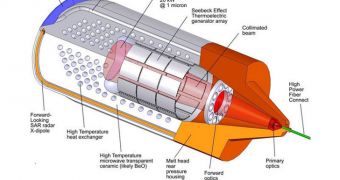Speaking at the NASA Astrobiology Science Conference, in Atlanta, on April 19, inventor and explorer Bill Stone proposed a new approach to drilling through miles of ice on alien moons. He believes that fiber optics and high-energy laser beams are the way to achieve efficiency in these endeavors.
Celestial bodies such as Saturn's Enceladus and Jupiter's Europa are of great interest to astronomers, since liquid oceans may lie under the thick layers of ice at their surface. Drilling through these barriers is possible, but will require a number of innovations.
Stone says that exploration rovers powered by remote, high-energy laser beams – relayed through miles of fiber optics cables – could conduct the necessary digs relatively fast. A 5,000-watt laser, he argues, could send a robot about 250 meters (820 feet) underneath the ice.
The prototype cryobot the researcher showcased is cylindrical, measuring 6 feet by 10 inches (1.8 meters by 25 centimeters). As it moves through the ice, a spool of fiber optic cable unspools behind it, from a laser generator that is left at the surface, Wired reports.

 14 DAY TRIAL //
14 DAY TRIAL //